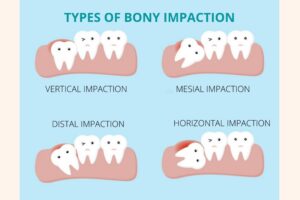
07 Jun WISDOM TOOTH PAIN AND ITS MANAGEMENT
The wisdom tooth is the third molar and the last tooth to erupt at the back of the mouth. It starts erupting after the age of 17 – 18 years in most cases. There are usually four wisdom teeth. Two on either side of the upper jaw is the maxilla and two in the lower jaw is the mandible.
In most cases, due to lack of space, the molars do not erupt completely. In such cases, the third molar has a tendency to exert pressure on the tooth ahead. When the wisdom teeth have insufficient space they are termed as impacted wisdom teeth. During cases like these, impacted teeth can cause severe pain due to the pressure being exerted by the eruption. The pain can radiate from the jaw to the ear and head causing mild to severe headaches.
Wisdom teeth, because they are located at the end, cleaning that area purely with brushing will not suffice. Regular professional cleaning which is called scaling needs to be done. Scalers have an ultrasonic tip that does not wear off the enamel while cleaning the tooth surface. Maintaining good oral hygiene becomes easier when patients are regular for their hygiene appointment.

Symptoms of wisdom tooth pain
- Decreased mouth opening
- Pain while opening the mouth
- Swollen gums around the third molar or corner of the mouth
- The patient has an unpleasant taste in their mouth
- The patient complains of halitosis which is bad breath
- Extraoral swelling
- Headache
- Radiating pain along the jaw
- The patient finds it difficult to swallow
In some cases, the pain comes and goes. They are intermittent in nature. And in some cases, the patient may not even experience any pain. However, only an OPG X-ray can conclude if the wisdom tooth is impacted or not.
Types of impacted wisdom tooth
- Horizontal Impaction: as seen in the picture above, horizontally impacted wisdom teeth are horizontally placed in the jaw bone that is it is in a sleeping position. This causes the wisdom tooth to push the tooth in front of it and in some cases it also causes cavities on the tooth ahead of it.
- Vertical Impaction: here the tooth is in an upright position however, it might be too close to the second molar which causes an obstruction during its eruption period. In some cases, the jaw bone can also create an obstruction while the tooth is trying to come out as it is placed in the corner of the jaw. These factors result in pain and discomfort due to the pressure developing around it.
- Mesial impaction: Mesial impacted teeth are also known as angular impactions. They are inclined at an angle to the tooth ahead of it and they partially erupt. You can see a part of the crown portion inside the mouth but because they are at an angle, they are unable to erupt completely. Mesi ally impacted teeth are prevalent and they tend to cause a lot of food entrapment because of the space created between the two tooth surfaces. This can also cause cavity formation as maintaining hygiene in such areas are very difficult.
- Distal Impaction: As you can see in the picture, distally impacted teeth are similar to mesially impacted wisdom teeth. However, the only difference is that it is angled in the other direction, towards the corner of the jaw. As the jaw is also at an angle, the tooth is obstructed by the jaw bone during its eruption.
What are the probable causes of wisdom tooth pain?
- Insufficient space: Due to lack of sufficient space, the impacted tooth exerts a lot of pressure on the adjacent hard and soft tissue causing pain and discomfort to the patient.
- Genetic Factors: Genetics plays a role in wisdom tooth pain. Depending on the jaw development of the ancestors, the same may follow in the future generation.
Ways to prevent impacted wisdom teeth?
The problem of wisdom teeth cannot be prevented, unfortunately. However, with regular check–ups and xrays, one can diagnose the level and type of impaction as well as the growth of the wisdom teeth.
What is the line of treatment for wisdom tooth pain?
- Surgical Extraction: surgical extraction is performed in cases of impacted wisdom teeth. Impacted teeth are stuck un the bone due to which a normal extraction would not suffice. In cases like these, an oral surgeon or an experienced dentist would surgically remove the tooth.
It requires some separation of gums around the extraction site along with some trimming of the surrounding bone. As the process is quite invasive, the patient is given a couple of sutures. The patient also may feel some discomfort and mild pain which is taken care of with antibiotics and painkillers.
- Conservative Approach: For patients who want to initially opt for a conservative approach, the dentist provides the wait-and-watch option where they are given mild painkillers to relieve the pain and then to see if the pain subsides and discomfort subsides automatically.
- Home remedies: warm salt water gargles, cold compress, pain killers, consume soft food for a few days.



